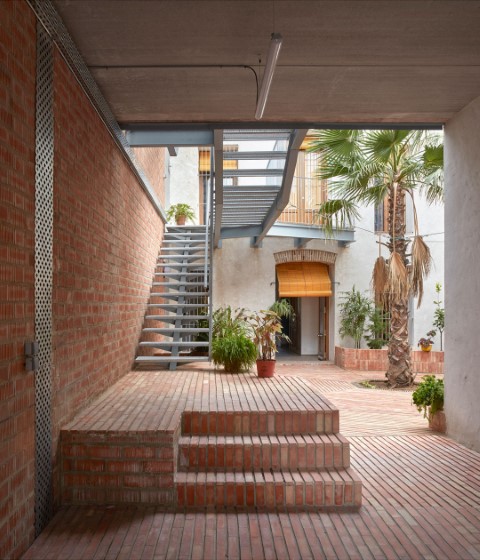The order of the project designed by Valor-Llimós arquitectura is strongly linked to the coastal Mediterranean climate. The result is a single volume of three heights connected to each other, whose proportions facilitate the stratification of hot air in summer, which is eliminated during the night without the use of mechanical systems.
As a support to this passive behaviour, construction systems with high thermal inertia are used, as well as the installation of a radiant floor fed by an aerothermal machine.
The relationship of this continuous interior with the street and the garden always takes place through intermediate spaces: patio, porch, terraces and balconies. These are protected with solar and visual filters, and act as a thermal cushion at the same time as they provide privacy and differentiate the different uses.
Description of project by Valor-Llimós arquitectura
Located in the old town of a small coastal village, on a plot previously occupied by a car park, the building houses a double use as dwelling and studio. The project is based on the desire to achieve climatic comfort through passive systems and seeks to integrate into the surrounding urban structure. All this is reflected in the choice and arrangement of the materials, in the attention paid to the pre-existences - such as the masonry partition wall that has been conserved - and the anonymity of the façade.
The coastal Mediterranean climate, with mild winters and warm summers with high humidity throughout most of the year, conditions the interior configuration and its relationship with the exterior. This is reflected in the heights and proportions of the interior spaces and their connections, such as the perforations between the three floors, which make it a single volume of three heights.
The relationship of this continuous interior with the street and the garden is always produced through intermediate spaces: courtyard, porch, terraces and balconies, protected with solar and visual filters, also serve to separate the dwelling and the studio. Thus, the order of the project is based on the relationships between qualities and uses rather than between forms or distributions.
Heavy construction systems such as concrete slabs and solid brick enclosures are chosen because of their thermal inertia, which plays a fundamental role in the desired passive functioning. This inertia allows for the damping and offsetting of both daily and seasonal thermal oscillation, and is especially indicated as it is a building with permanent occupation such as a dwelling that incorporates the workplace.
As far as materials are concerned, the choice is for exposed concrete and uncoated brick, unpainted wooden carpentries, continuous mortar floors and exterior cork coverings. In order not to alter the raw appearance of the materials, surface treatments such as waxes, oils or colourless lasures are used.
The situation between East-West oriented dividing walls makes it advisable to have solar protections, such as vertical adjustable slats or traditional pine wood rolling shutters, in front of all spaces susceptible to capturing radiation in summer. These filters generate intermediate spaces, suitable both as a thermal cushion and to provide privacy between the interior and exterior spaces or the different uses, while at the same time allowing solar capture in winter.
With regard to air-conditioning systems, the height of three metres in the rooms facilitates the stratification of the hot air in summer, which is eliminated during the night by means of the ventilation that is introduced into all the floors through high grilles and extracted through a solar chimney on the last floor, which avoids the need for mechanical air-conditioning systems.
As a support to this passive behaviour, in winter a radiant floor is chosen, fed by an aerothermal machine, whose performance is very high when working with low temperatures in a temperate climate, which provides comfort without heating the air with extremely low energy consumption. This system also admits the circulation of water cooled by the same machine which, combined with natural ventilation, provides the necessary comfort in summer.




































